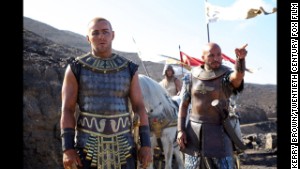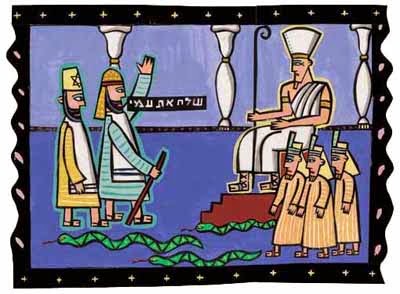Israeli military intelligence makes its predictions for 2015, but this year is not like other years.
.jpg)
The upcoming calendar year will be filled with changes in the Arab world and new challenges for Israel to face, according to the IDF annual ‘crystal ball’ report from military intelligence. None of that is news to anyone living in this region. But the more problematic part in the IDF MI annual assessment document is in the acknowledgement that beyond the first few months of 2015, it is really not possible to predict with any accuracy what the next year will bring. Israel’s entire leadership is in flux; a new IDF general chief of staff, Gadi Eizenkot, is taking the helm at the same time early elections are being held.
.jpg)
Any emerging victorious party chairman will be asked by President Reuven Rivlin to form
a new coalition, at a time that Israel is facing potentially serious threats on at least three (Lebanon, Syria, Gaza) of its five borders. A fourth border, that with Sinai, is questionable due to terror bases nestling in the region. That’s not including the internal threat Israelis face from the rising third intifada and the rabid anti-Israel media and government incitement encouraged by Palestinian Authority chairman Mahmoud Abbas, so beloved and lauded by international leaders. The United Nations Security Council is to vote Monday (Dec. 29, 2014) on a proposed deadline to force the expulsion of Israeli military forces from post-1967 territory. Either way the vote goes, the outcome and its fallout is not yet clear.
Meanwhile, there are other issues to consider when gazing into the Crystal Ball. The jostling for post-election ministerial portfolios, coalition bargaining and acclimation of new ministers and their seconds to their roles will be taking place at the same time new Knesset members will be learning their new jobs and jockeying for committee spots too. Many more experienced and savvy leaders are leaving the government, having had their fill of the bickering, vindictiveness and stupidity. Who will mind the store while all this is going on?
Folks, there’s a war going on. We’re not in the bomb shelters on a daily basis yet, but that doesn’t mean we’re out of the woods either. The sunny skies have a few clouds. According to the MI report, it is clear that chemical weapons still exist in Syria, what is left of it, that is, and are being used by someone. What is not clear is the extent of control exercised over that supply by President Bashar al-Assad. “Greater Syria” is no longer; Assad today refers to “Little Syria,” the 20 to 30 percent of the country he still controls, hence his belated attempt to “negotiate” with rebel leaders. Too little, too late, naturally. Syria has fallen apart, as has Libya – split into three states – and Sudan, now cut into two. There are no real “Syrian rebel leaders” today either. Instead there are “emirates” and “emirs” in the developing caliphate being created by the Islamic State in Iraq and Syria, the rapidly spreading ISIS terror organization.
ISIS has already taken over much of Iraq, and has done the same in Syria. The spoils of the land are divided up with its rebel partners in the civil war against Assad – Jabhat al Nusra, the Al Qaeda-linked Al Nusra Front and other terror groups. But they tend to fight against each other when they’re not banding together to fight against Assad’s forces – a bit like some of the Middle Eastern countries they have grown up in. Meanwhile, it’s not clear where the Free Syrian Army stands in all this: the more moderate, Muslim rebel force is as ruthless as any other, but not enslaved to anyone but its own leadership at least. For that reason, perhaps, it is this force the West has chosen to support, albeit grudgingly, fearfully, and surreptitiously.
Russia has had no such hesitations: despite Assad’s progressive loss of control, Moscow faithfully ships ordnance to the port of Tartus. The generous weekly flow of arms into the country is likely intended for the Hezbollah terrorist organization as much as it is for the Syrian Army they are aiding. After all, Hezbollah is a protege of Iran, where Russia has been assisting with the construction of nuclear reactors for years.
This process has also furthered the presence of the elite Iranian Revolutionary Guards, who were sent initially as advisers and consultants. They soon became commanders, and eventually a controlling force. In fact, IRG soldiers were photographed lounging around near Lebanon’s border with Israel in October, according to the Middle East Media Research Institute. The photographs of the Guards were uploaded to a Twitter account linked with the force, and had been published a week and a half earlier on an Iranian military website, according to the MEMRI report. The photos proclaimed in a headline, “Islamic Republic soldiers are on the border of Occupied Palestine!”
 |
| Golan Heights |
These forces have built a strong bond with Gaza’s ruling Hamas terrorist organization on Israel’s southern border and are now trying to create an iron-fisted axis with which to strike Israel in a multi-front war. The possible buffer in the Golan Heights results from positive relations that Israel has established via medical treatment with moderate rebel forces in the Golan Heights regions. Along the Lebanese border Israel is building an underground security barrier to block terror tunneling attempts by Hezbollah. The lessons learned from the IDF 2014 Operation Protective Edge against Hamas in Gaza were hard-won, but they were thorough.
In the south along the Sinai border, Israel’s good fortune lies with Egypt’s President Abdel Fattah al-Sisi, who has no love for the Muslim Brotherhood, which he outlawed, and its terror-child, Hamas, which he sees as destroying Egypt’s economy. Sisi is also committed to ridding the Sinai Peninsula of the anti-government terrorist nests that have taken root there but whether he will succeed remains to be seen. A river of Egyptian blood has already washed the sands of the Sinai; both Al Qaeda and ISIS have planted bases there in addition to Hezbollah, Hamas and local affiliates.
In Gaza, it is estimated Hamas has purchased concrete from some 80,000 homeowners who received the building materials from international donors who believed they would use them to rebuild their own homes. And so Hamas is indeed “rebuilding” Gaza – underground Gaza, that is – its intricate honeycomb network of terror tunnels used for attacking, murdering and kidnapping Israelis. Of course, some of the tunnels are also used for smuggling supplies as well: weapons, building supplies with which to build more tunnels, explosives, military equipment, etc. A few of the tunnels are also used to bolster the Gaza economy with luxury items as well. None are used to build subways, transportation infrastructure, sewage systems or anything that might further develop the quality of life for Gazans. Clearly, Gazans don’t mind; if they did, they wouldn’t have sold their concrete to Hamas – they would have used it to repair their homes.
When or how the conflict will come is not clear, and Israel’s military intelligence cannot and will not simply roll the dice for an answer. Sadly, only one thing is certain: it will come.
When it does,
THE IDF WILL BE READY.
.jpg)

.jpg)

.jpg)
.jpg)


.jpg)

.jpg)
.jpg)
.jpg)
.jpg)
.jpg)
.jpg)
.jpg)
.jpg)
.jpg)
.jpg)







.jpg)
.jpg)









.jpg)
.jpg)
.jpg)


.jpg)

